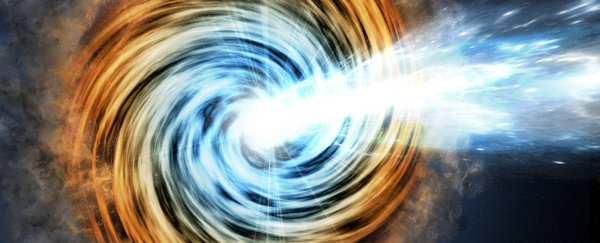NASA has picked up intense gamma ray signals coming from a set of ancient galaxies. The gamma rays are being blasted out by objects known as blazars, which surround some of the biggest and most powerful black holes we've ever encountered.
The discovery could change our understanding of how black holes came together in the earliest moments of the Universe, because these signals are coming from galaxies that formed when it was only 1.4 billion years old - a tenth of its present age.
These gamma ray signals might have originated 1.4 billion years after the Big Bang, but they're just now reaching our telescopes, finally allowing us to peer back in time and understand more about huge, ancient blazars, and their associated black holes.
Blazars exist at the core of very active, giant elliptical galaxies that contain supermassive black holes with 1 million or more times the mass of our Sun.
As material falls into these black holes, they emit highly powerful jets of energy, which move at close to the speed of light.
When these jets of energy are pointed towards Earth, they can give us insight into the black holes that formed them, and the fact that these newly discoverd blazars come from so far away means we're now able to study some of the oldest black holes ever found.
"Despite their youth, these far-flung blazars host some of the most massive black holes known," says astronomer Roopesh Ojha from NASA's Goddard Space Flight Centre.
"That they developed so early in cosmic history challenges current ideas of how supermassive black holes form and grow, and we want to find more of these objects to help us better understand the process."
The incoming blazar energy was picked up by NASA's Fermi Gamma-Ray Space Telescope, and is coming from five galaxies that formed when the Universe was just 1.4 billion years old.
Although gamma rays can't be seen by the naked eye, they're streaming in great quantities across the Universe all the time.
We're not exactly sure where all this background gamma-ray information comes from, but blazar galaxies are one of the few known sources that we've identified.
Blazars appear particularly bright to our scientific instruments because their jets of light energy are pointed directly at our planet. But until now, the oldest light we'd seen was from a blazar dated back to 2.1 billion years after the Universe first formed.
Recent accuracy improvements in the way data from satellites and telescopes is analysed has meant we can peer deeper into space than ever before, spotting even older galaxies, such as the set the Fermi Space Telscope has now stumpled upon.
And not only did the black holes at the heart of these five new blazars form when the Universe was very young - they're incredibly powerful as well, each pumping out more than 2 trillion times the energy output of our Sun.
"The main question now is how these huge black holes could have formed in such a young universe," says another of the team, Dario Gasparrini from the Italian Space Agency's Science Data Centre. "We don't know what mechanisms triggered their rapid development."
Trying to understand those mechanisms is one of the next steps researchers could take, but NASA scientists also want to look for other blazars similar to these to get a broader range of data on how they're put together.
As one of the researchers, Marco Ajello from Clemson University in South Carolina, puts it: "We think Fermi has detected just the tip of the iceberg, the first examples of a galaxy population that previously has not been detected in gamma rays."
The findings are in the process of being peer-reviewed, having been presented to the American Physical Society and submitted to the Astrophysical Journal Letters.
